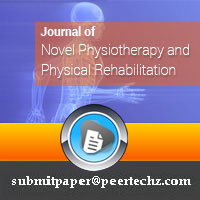Journal of Novel Physiotherapy and Physical Rehabilitation
Applicability of immersive virtual reality for training with the myoelectric prosthesis in upper extremity amputated patients: “A clinical case report”
Jordi Calvo Sanz1,2*, Lluis Guirao Cano3, Beatriz Samitier Pastor1, M Angeles Díaz Vela1, Vanesa Rodríguez Salés2 and Pol Monné Cuevas1
2Departament de Salut. Centre Universitari Tecnocampus Mataró (TCM)-Universitat Pompeu Fabra (UPF). Mataró. España, Grup de Recerca en Tecnologia Aplicada a l’Alt Rendiment i la Salut (TAARS). Spain
3Hospital Universitario Mútua de Terrassa, Spain
Cite this as
Calvo Sanz J, Guirao Cano LL, Samitier Pastor B, Diaz Vela MA, Rodriguez Salés V, et al. (2022) Applicability of immersive virtual reality for training with the myoelectric prosthesis in upper extremity amputated patients: “A clinical case report”. J Nov Physiother Phys Rehabil 9(2): 017-018. DOI: 10.17352/2455-5487.000097Copyright
© 2022 Calvo Sanz J, et al. This is an open-access article distributed under the terms of the Creative Commons Attribution License, which permits unrestricted use, distribution, and reproduction in any medium, provided the original author and source are credited.Introduction
The integration of Virtual Reality (VR) in the rehabilitation process of the upper extremity amputee patient reinforces motor learning, facilitates the incorporation of the prosthesis in the body scheme, and normalizes global gesturing. Real-time biofeedback in scenes and games with motor actions also related to Activities of Daily Living (ADLs), allows the patient to perform a motor gesture with motivating objectives that allow the execution of actions and assess their performance.
Objective
The main objective was to favor the obtainment of gestures and prosthetic control through VR for their incorporation into functional patterns in ADLs in an amputee patient who uses a myoelectric prosthesis (PM).
Materials and methods
A 46-year-old patient with a transradial amputation of the right upper extremity, the user of PM Michelangelo (Ottobock). The software designed by Carlos III University of Madrid (UC3M) was used with connection to the “Oculus Rift S” glasses. The session lasted 30-45 minutes (according to tolerance), before the VR the training was carried out for correct prosthetic management, executing different grips, tweezers, and combined movements.
The progression of each exercise was performed in the following order:
- Healthy hand.
- Prosthetic hand.
- Bimanual.
The work with VR was carried out in 2 phases:
F1-Exploration and adaptation to virtual space
F2 Gesture training and prosthetic control for grips and reaches
Results
The application of VR in combination with conventional treatment offers significant benefits in functionality, learning of correct motor execution in real-time and on the motivational and emotional state in amputees of upper extremity carriers of the myoelectrical prosthesis, shortening training times and improving the integration of the prosthetic limb in the body scheme. In turn, VR through visual and auditory feedback allows objectifying the gains and knowing the evolution in the exercise program and adapting the level of difficulty at all times with the level of achievement obtained.
Discussion
The use of VR in combination with conventional treatment in the rehabilitation of the amputee patient with PM shows to have benefits on functionality [1], following the results obtained in neurological pathology: spinal cord injuries, stroke [2,3], and traumatic shoulder pathology [4-6].
Conclusion
The playful nature of VR with an important motivational component and adherence to treatment facilitates certain motor learning, unlike conventional rehabilitation where the method is usually more monotonous. Although VR shows a beneficial effect, more studies of high methodological quality are needed to delve into the changes produced concerning cortical reorganization and neuroplasticity on motor recruitment, as well as to determine whether these results are maintained over time. It is necessary to define the type of VR used (immersive, non-immersive, semi-immersive), the frequency, intensity, and time of the session that can be individualized [3,7,8], so as not to cause discomfort due to overexposure or fatigue (visual disturbances, headaches, postural pain, etc) in the use of VR devices.
- Resnik L, Etter K, Klinger SL, Kambe C. Using virtual reality environment to facilitate training with advanced upper-limb prosthesis. J Rehabil Res Dev. 2011;48(6):707-18. doi: 10.1682/jrrd.2010.07.0127. PMID: 21938657.
- García-García E, Sánchez-Herrera Baeza P, Cuesta-Gómez A. Efectividad de la realidad virtual en la rehabilitación del miembro superior en la lesión de la médula espinal. Revisión sistemática. Rev neurol. (Ed. impr.). 2019; 135-144.
- Ogourtsova T, Archambault PS, Lamontagne A. Post-stroke unilateral spatial neglect: virtual reality-based navigation and detection tasks reveal lateralized and non-lateralized deficits in tasks of varying perceptual and cognitive demands. J Neuroeng Rehabil. 2018 Apr 23;15(1):34. doi: 10.1186/s12984-018-0374-y. PMID: 29685145; PMCID: PMC5913876.
- Sveistrup H, McComas J, Thornton M, Marshall S, Finestone H, McCormick A, Babulic K, Mayhew A. Experimental studies of virtual reality-delivered compared to conventional exercise programs for rehabilitation. Cyberpsychol Behav. 2003 Jun;6(3):245-9. doi: 10.1089/109493103322011524. PMID: 12855079.
- Chen CC. Multimedia virtualized environment for shoulder pain rehabilitation. J Phys Ther Sci. 2016 Apr;28(4):1349-54. doi: 10.1589/jpts.28.1349. Epub 2016 Apr 28. PMID: 27190481; PMCID: PMC4868241.
- Gumaa M, Rehan Youssef A. Is Virtual Reality Effective in Orthopedic Rehabilitation? A Systematic Review and Meta-Analysis. Phys Ther. 2019 Oct 28;99(10):1304-1325. doi: 10.1093/ptj/pzz093. PMID: 31343702.
- Ekman U, Fordell H, Eriksson J, Lenfeldt N, Wåhlin A, Eklund A, Malm J. Increase of frontal neuronal activity in chronic neglect after training in virtual reality. Acta Neurol Scand. 2018 Oct;138(4):284-292. doi: 10.1111/ane.12955. Epub 2018 May 16. PMID: 29770439.
- Kuttuva M, Burdea G, Flint J, Craelius W. Manipulation practice for upper-limb amputees using virtual reality. Presence: Teleoperators & Virtual Environments. 2005; 14(2): 175-182.
Article Alerts
Subscribe to our articles alerts and stay tuned.
 This work is licensed under a Creative Commons Attribution 4.0 International License.
This work is licensed under a Creative Commons Attribution 4.0 International License.




 Save to Mendeley
Save to Mendeley
